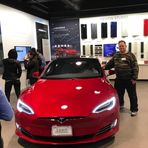Tesla's Robotaxi Revolution: A New Era in Autonomous Transportation
June 23, 2025, 3:39 am

Location: United States, California, Foster City
Employees: 1001-5000
Founded date: 2014
Total raised: $700M

Location: United States, Texas, Austin
Employees: 10001+
Founded date: 2003
Total raised: $3.86B

Location: United States, California, Mountain View
Employees: 1001-5000
Founded date: 2009
Total raised: $19.17B
In the heart of Austin, Texas, a new chapter in transportation has begun. Tesla has launched its long-anticipated robotaxi service, marking a significant milestone in the race for autonomous vehicles. This trial, though small, is a bold step into a future where cars drive themselves. With Elon Musk at the helm, the stakes are high, and the world is watching.
The scene is set. A handful of Tesla Model Ys glide silently through the streets of South Congress Avenue. No driver in sight. Just a passenger, a safety monitor, ready to intervene if needed. This is not science fiction; it’s reality. For a flat fee of $4.20, select riders can experience the future of transportation. But this is just the beginning.
Musk describes this launch as the "culmination of a decade of hard work." Yet, the road ahead is fraught with challenges. Industry experts caution that while this trial is a significant step, it’s merely the "end of the beginning." The path to a fully operational robotaxi service is long and winding.
Tesla's approach is unique. Unlike competitors like Waymo and Zoox, which rely on a mix of technologies, Tesla leans heavily on cameras. Musk believes this method is safer and more cost-effective. However, it raises eyebrows. Will cameras alone be enough to navigate the complexities of urban driving?
Safety is paramount. Musk has promised a cautious rollout, avoiding bad weather and tricky intersections. Riders must be over 18, and the vehicles will operate in limited areas. This careful approach reflects the company’s commitment to safety, especially after a decade of unfulfilled promises.
The legal landscape is shifting too. Texas has enacted new regulations for autonomous vehicles, requiring permits for operation. This law, signed by Governor Greg Abbott, signals a more cautious approach to the driverless vehicle industry. It’s a double-edged sword. While it allows innovation, it also imposes restrictions. Tesla must navigate this regulatory maze carefully.
The competition is fierce. Waymo has been offering fully autonomous rides for some time, setting a high bar. Zoox, backed by Amazon, is gearing up for its own launch. Tesla’s trial is a direct challenge to these established players. The question looms: can Tesla catch up and surpass them?
Investors are holding their breath. Tesla’s stock value is closely tied to its success in the robotaxi market. A successful trial could send shares soaring. Conversely, failure could lead to a steep decline. The pressure is immense.
The public's reaction is mixed. Social media influencers have shared their experiences, showcasing the excitement surrounding the launch. Yet, skepticism remains. Can Tesla deliver on its promises? Will the robotaxi service be safe and reliable?
The technology behind these vehicles is groundbreaking. Tesla has developed its AI chip and software from scratch. This innovation could give it an edge over competitors. However, the company must prove that its technology can handle real-world challenges.
As the trial unfolds, the world will be watching closely. Will Tesla’s robotaxi service become a game-changer in the transportation industry? Or will it be another ambitious dream that falls short?
The implications are vast. A successful robotaxi service could reshape urban mobility. Imagine a world where cars are no longer a necessity. Where rides are just a tap away. This vision is tantalizing, but it’s still a long way off.
In the meantime, Tesla must focus on the present. The Austin trial is just a small piece of a much larger puzzle. The company must refine its technology, navigate regulatory hurdles, and build public trust. Each step is crucial.
As the sun sets over Austin, the future of transportation hangs in the balance. Tesla’s robotaxi service is a bold experiment, a leap into the unknown. The journey has just begun, and the road ahead is uncertain. But one thing is clear: the world of transportation is on the brink of transformation.
In this race for autonomy, Tesla is not just a participant; it aims to lead. The stakes are high, and the potential rewards are enormous. The question remains: can Tesla turn its vision into reality? Only time will tell.
As we watch this unfold, one thing is certain: the future of transportation is here, and it’s electric. The robotaxi revolution has begun, and it promises to change the way we move. Buckle up; it’s going to be a wild ride.
The scene is set. A handful of Tesla Model Ys glide silently through the streets of South Congress Avenue. No driver in sight. Just a passenger, a safety monitor, ready to intervene if needed. This is not science fiction; it’s reality. For a flat fee of $4.20, select riders can experience the future of transportation. But this is just the beginning.
Musk describes this launch as the "culmination of a decade of hard work." Yet, the road ahead is fraught with challenges. Industry experts caution that while this trial is a significant step, it’s merely the "end of the beginning." The path to a fully operational robotaxi service is long and winding.
Tesla's approach is unique. Unlike competitors like Waymo and Zoox, which rely on a mix of technologies, Tesla leans heavily on cameras. Musk believes this method is safer and more cost-effective. However, it raises eyebrows. Will cameras alone be enough to navigate the complexities of urban driving?
Safety is paramount. Musk has promised a cautious rollout, avoiding bad weather and tricky intersections. Riders must be over 18, and the vehicles will operate in limited areas. This careful approach reflects the company’s commitment to safety, especially after a decade of unfulfilled promises.
The legal landscape is shifting too. Texas has enacted new regulations for autonomous vehicles, requiring permits for operation. This law, signed by Governor Greg Abbott, signals a more cautious approach to the driverless vehicle industry. It’s a double-edged sword. While it allows innovation, it also imposes restrictions. Tesla must navigate this regulatory maze carefully.
The competition is fierce. Waymo has been offering fully autonomous rides for some time, setting a high bar. Zoox, backed by Amazon, is gearing up for its own launch. Tesla’s trial is a direct challenge to these established players. The question looms: can Tesla catch up and surpass them?
Investors are holding their breath. Tesla’s stock value is closely tied to its success in the robotaxi market. A successful trial could send shares soaring. Conversely, failure could lead to a steep decline. The pressure is immense.
The public's reaction is mixed. Social media influencers have shared their experiences, showcasing the excitement surrounding the launch. Yet, skepticism remains. Can Tesla deliver on its promises? Will the robotaxi service be safe and reliable?
The technology behind these vehicles is groundbreaking. Tesla has developed its AI chip and software from scratch. This innovation could give it an edge over competitors. However, the company must prove that its technology can handle real-world challenges.
As the trial unfolds, the world will be watching closely. Will Tesla’s robotaxi service become a game-changer in the transportation industry? Or will it be another ambitious dream that falls short?
The implications are vast. A successful robotaxi service could reshape urban mobility. Imagine a world where cars are no longer a necessity. Where rides are just a tap away. This vision is tantalizing, but it’s still a long way off.
In the meantime, Tesla must focus on the present. The Austin trial is just a small piece of a much larger puzzle. The company must refine its technology, navigate regulatory hurdles, and build public trust. Each step is crucial.
As the sun sets over Austin, the future of transportation hangs in the balance. Tesla’s robotaxi service is a bold experiment, a leap into the unknown. The journey has just begun, and the road ahead is uncertain. But one thing is clear: the world of transportation is on the brink of transformation.
In this race for autonomy, Tesla is not just a participant; it aims to lead. The stakes are high, and the potential rewards are enormous. The question remains: can Tesla turn its vision into reality? Only time will tell.
As we watch this unfold, one thing is certain: the future of transportation is here, and it’s electric. The robotaxi revolution has begun, and it promises to change the way we move. Buckle up; it’s going to be a wild ride.
